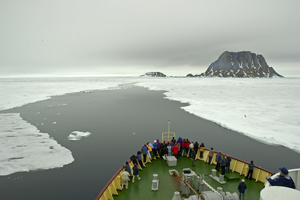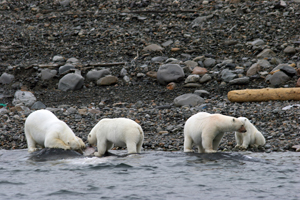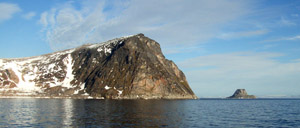In the very north of Svalbard, in the ocean north of Nordaustlandet, is the little archipelago of Sjuøyane (the seven islands), with its characteristically hat-shaped mountains. The hard granite mountains have acquired a green covering of moss due to thousands of breeding seabirds. Walrus dive for clams in the waters between the islands and in the bays. Most of the islands have been named after the English North Pole expeditions led by Phipps (1773) and Parry (1827).
 The island of Rossøya (left) and Vesle Tavleøya. Rossøya is situated at 80 degrees and 49.5 minutes north and is therefore Svalbard’s northernmost point. (Image: Jørn Henriksen)
The island of Rossøya (left) and Vesle Tavleøya. Rossøya is situated at 80 degrees and 49.5 minutes north and is therefore Svalbard’s northernmost point. (Image: Jørn Henriksen)
 Isflakbukta on Phippsøya. (Image: Bjørn Fossli Johansen / The Norwegian Polar Institute)
Isflakbukta on Phippsøya. (Image: Bjørn Fossli Johansen / The Norwegian Polar Institute)
 Polar bears partaking of a stranded whale carcass in Eidsbukta on Phippsøya in the summer of 2006. (Image: Arild Lyssand / The Governor of Svalbard)
Polar bears partaking of a stranded whale carcass in Eidsbukta on Phippsøya in the summer of 2006. (Image: Arild Lyssand / The Governor of Svalbard)
 The headland of Høgneset on the island of Parryøya, with the island of Nelsonøya to the right. (Image: Bjørn Fossli Johansen / The Norwegian Polar Institute)
The headland of Høgneset on the island of Parryøya, with the island of Nelsonøya to the right. (Image: Bjørn Fossli Johansen / The Norwegian Polar Institute)
Sjuøyane are located at about 80 degrees and 45 minutes north. The mountains, of gneiss and granites, are tied together by plains created by deposits, which have given the islands their large, semi-circular bays.
The warm West Spitsbergen Current (which is a branch of the Gulf Stream) turns north-east towards Sjuøyane, resulting in a relative long open water season. However, the ice edge is rarely far away.
In general the sparse vegetation belongs to the Arctic polar desert zone. However, fertilization by bird droppings provide a breeding ground for mosses and scurvygrass (Cochlearia groenlandica), which give some of the mountains their characteristic greenish colour.
When the ice breaks up around Sjuøyane and the first seabirds return in April–May, the islands wake again after a long winter, during which the only wildlife is the odd polar bear, Arctic fox, reindeer and walrus. There is a large number of bird cliffs in Sjuøyane, scattered around most of the islands. Little auks come in the largest numbers, but there are also several smaller colonies of Atlantic puffins and Brünnich’s guillemots. Common guillemots nest scattered around the islands. One of the few known colonies of ivory gulls can be found on Phippsøya. Ivory gulls are categorized as Near Threatened in the IUCN Red List of Threatened Species.
There are also several haul-out sites for walrus on Sjuøyane. The most reliable place to encounter them is Isflakbukta on the island of Phippsøya. Up to 100 animals can be seen on the beach, and normally walrus are very active in the shallow bay. Landings by tourist groups must take place with extreme caution and without disturbing the walruses. If calves are observed boats must keep to a greater distance and going ashore is not permitted . If the walrus population in Svalbard continues to grow, it is likely that females and calves will be a more frequent sight at the haul-out sites. This means that anyone visiting the area must exercise caution.
In Isflakbukta there is a cabin that was originally built during the expedition of mining inspector Hans Merckoll in 1936. It is one of several emergency cabins that were erected in the east of Svalbard to help people in need, for example, when ships sank. The cabin is protected as a cultural remain by the Governor of Svalbard and is well preserved.
Polar bears can be seen anywhere on Sjuøyane. The polar bear distribution is strongly related to the distribution of sea ice. If there is drift ice around the islands it is more likely that there will be polar bears on the islands. Usually there are also a few polar bears remaining in the area over the summer.
There are reindeer on Sjuøyane, but the number is unknown and probably quite low. These animals must have come over from Nordaustlandet, and exchange with the Nordaustlandet population is probably a premise for the existence of reindeers on this northernmost tip of Svalbard. In the summer of 2004 footprints from three reindeer were found on a sandy beach on the island of Martensøya. A reindeer was seen here in 2006. A hard winter, when the grazing grounds freeze, could easily lead to them all perishing. Arctic foxes can also be found on Sjuøyane, but there are no known dens in the area.